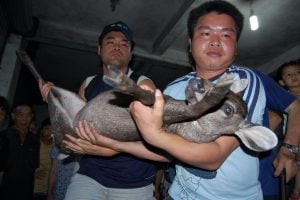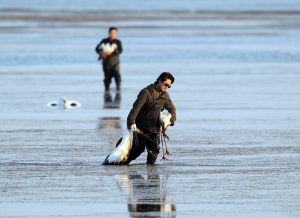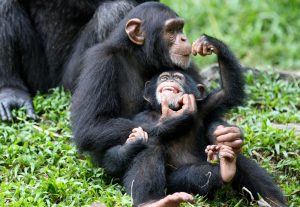A wolf roars in mid-pounce. The head of a wild boar stares blankly from the wall. Two tigers face off. And everyone is aware of the elephant in the room, waiting to have its tusks fitted.
Welcome to the “legal” animal specimen market.
Zhang Zhaoguo, boss of a State Forestry Administration-certified taxidermy firm, provides rich collectors with reliable and high quality services: his offerings of stuffed
rare or endangered species are all legally-certified. “Rest easy,” he says. “As long as the item comes with a certificate, you can buy and sell it legally within China.”
Once used for science and education, stuffed animal specimens are now bought and sold for huge profits. “The South China tiger is small, so they might not look quite so good,” Zhang told a Southern Weekend reporter masquerading as a potential customer.
He has a range of different types: “This is a Bengal tiger, more or less the same price,” he says, pointing at another sample. “If you want something for luck, a white tiger is good. Like the green dragon and white tiger in Daoism.”
On the phone the head of his company’s Shanghai office pushed other products: “We can also do elephants, they ward off evil. They’re the biggest land animal, if you’re interested I can take you to see one.”
And there are other companies almost openly peddling stuffed tigers to private collectors. In provinces such as Fujian and Anhui the majority of licensed taxidermists said they could do so, with only one refusing.
This tallies with the findings of the
Environmental Investigation Agency, a UK independent environmental organisation. From May 2012 to January 2013 the EIA carried out studies of the trade in tiger skins in China.
The EIA found that the Xiafeng Arts Specimen Factory in Chaohu, Anhui, was making luxury rugs out of tiger skins listed for use as specimens. An animal rescue centre in Beidaihe, Hebei, was selling large numbers of tiger skins intended for research and education to rich collectors. In the first half of 2012 it sold 5 – all as rugs, and all with government certification.
These specimens, originally intended for research or education, have created a huge and profitable market.
According to insiders a Siberian tiger can be bought from a zoo for 50,000 or 60,000 yuan, but its skin goes on the black market for 350,000 to 600,000 yuan. A corpse of the rare South China tiger would cost something under 600,000 yuan, but sell for 3 million yuan as a finished product.
There have long been question marks over the role of zoos, the main legal source of animals for taxidermists, in this grey trade. “Zoos are the most important part of the chain,” said the head of one taxidermy firm, asking to remain nameless.
Chinese law rules that organisations such as zoos and circuses can buy and sell certain quantities of wild animals, at government-set prices. But “except in extraordinary circumstances”, zoos bear no responsibility for the death of an animal – they just have to report the time and an approximate cause of death.
“Natural death and loss” have therefore become common events in Chinese zoos. “The official price for a live tiger is sometimes less than 20,000 or 30,000 yuan. If you can have it die a “natural death”, you can make a lot more money,” explained the same source.
And there’s no shortage of business for the taxidermists. Businesspeople and
government officials are the purchasers and collectors – products are often given as gifts between the two groups. “It’s a sign of status and quality, and it’s easier to accept than cash,” said the same source. Purchases are often made due to animals appearing in Chinese idioms – there is one about the ferocity of tigers, while the Chinese word for deer is homophonous with part of an idiom about getting rich. And monkeys and elephants, the kings of the animal kingdom, are also popular.
“Specimens with the certificate, and in particular rare or endangered animals, are still mainly used for education and research. We don’t encourage private collections. For protected animals we’ve always advocated museum collection.” An animal conservation employee with the Fujian forestry authorities explained the government stance.
But he refused to state whether private sales were illegal, only repeating that this was “not encouraged.”
Many industry insiders say that this ambiguity has allowed the trade to flourish in recent years. For a time after signing up to the Convention on International Trade in Endangered Species (CITES), China clamped down on the trade in tiger products, with a full ban on the trade in tiger bones instituted in 1993. But in 2003 the State Forestry Administration and the State Administration of Industry and Commerce announced trials in which the trade of certified rare animal products would be permitted – again, the tigers were at risk.
The rules allowed legal tiger breeding centres to register tiger corpses with the SFA. Licensed firms could then apply to purchase those skins. Once stuffed or processed into rugs, the license holder could then submit documents and photographs to the SFA in order to obtain a certificate for the item, allowing it to be sold or transferred within China.
“We asked the SFA, and they said specimens could only be used for science and education,” said Vicky Lee of the EIA. “But look at what’s actually being made and you can see it’s intended for decoration.”
At Zhang Zhaoguo’s factory, the products are displayed like artworks – two stuffed tiger cubs are even placed on a mock mountain. “We’ve sent them [the SFA] photographs,” said Zhang. If that is so, then the authorities are well aware of how the products are used. “Overseas, rare captive animals are not normally stuffed,” explained
Debbie Banks, tiger campaigner for EIA. “And when they are it is only for scientific or educational institutions. But in China the SFA permits the companies to make and sell them for profit.” This goes against the international norm of use only for science and education.
And the certificates themselves are a problem. The only way to match up a certificate and the item it belongs to is the photograph: the taxidermists will photograph the product and send that image to the SFA, who add it to a laminated and stamped certificate.
But the photographs on the certificates are no larger than a fingernail – nowhere near large enough to identify any particular tiger skin. This means the certificate could be used for other skins.
“That has been reported,” said Meng Zhibin, director of the office of the Endangered Species Scientific Commission. He has heard of sellers asking buyers if they need the certificate – if not, they get a discount, and the certificate can be reused. “Unfortunately the authorities haven’t been able to find the staff or funding to supervise this.”
The SFA did not respond to requests for an interview.
“They’ve already lost their original meaning,” complains Tang Zhaohe, a fourth-generation taxidermist who works at Fujian Normal University’s natural history collection. “It’s about preserving rare animals, not decorations to look good.” Tang’s family was once highly influential in the study of China’s natural history. But they are saddened by the way the craft has developed. “Beasts and birds of prey, beautiful birds, they’re making ornaments, not specimens,” said Tang Jian, a fifth-generation member of the family and head of Wuhan University’s natural history collection.
“The taxidermists only want big beautiful birds, not small ones,” said Tang Zhaohe. “And the new museums only want big beautiful specimens too.”
But that importance of preserving these samples isn’t in their looks – he once collected examples of six birds from Wuyi Mountain, all smaller than a sparrow, and all ugly.
Worse, while the collectors’ market is flourishing, the university collections intended for science and research are in trouble.
Wuhan University provides one example: the earliest of China’s collections of animal samples, prior to 1998 it was the country’s biggest and best. But now they struggle to even preserve the specimens they have. “They need constant temperature and humidity, but we can’t even afford formalin and formaldehyde for preservation,” complained Tang Jian. “And we have to count the pennies to pay the power and water bills.”
This article was originally published in the Southern Weekend on August 22. Lu Minghe is a Southern Weekend reporter.







